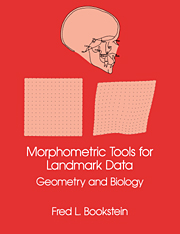8 - Retrospect and prospect
Published online by Cambridge University Press: 23 November 2009
Summary
Chapter 1 set out four principles that I claimed would underlie all the tools and tactics of this treatise. By now, many exhaustively worked examples later, those principles have been fairly thoroughly exploited. In these closing comments I would like to remind the faithful reader of what has been covered so far, but mainly I want to touch on what this tool kit has produced – what seems to me to be temporary scaffolding, and what I believe to be built in stone, to last. Though I am proud of the masonry, it is the scaffolding that interests me most. Its struts and lacework jump across many conceptual gaps in the metrological discipline laid out here. Behind the facade lie many open questions at the joint frontier of algebra and mathematical biology for these techniques. As Chapter 3 emphasized, the locations of landmarks are conveniences for the attachment of biological explanations to form.Different explanations leave their traces in form in different ways; our statistical algebra and geometry must be free to adapt appropriately.
FIRST PRINCIPLE: LANDMARK LOCATIONS
Routine procedures
The first step in any landmark-based morphometric analysis is to collect well-placed landmarks (Chapter 3). As a configuration, they must encompass the trace in tissue of the biomechanical or other determinants of form the covariances of which are to bfe unearthed by the morphometric analysis. They should provide reasonably even coverage of the form; they should appear to correspond both geometrically and biologically from specimen to specimen; and they should be of Type 1 (discrete juxtapositions of tissues) in preference to Type 2 (extrema of curvature), and of Type 2 in preference to Type 3 (extrema of single coordinates)
- Type
- Chapter
- Information
- Morphometric Tools for Landmark DataGeometry and Biology, pp. 358 - 372Publisher: Cambridge University PressPrint publication year: 1992



